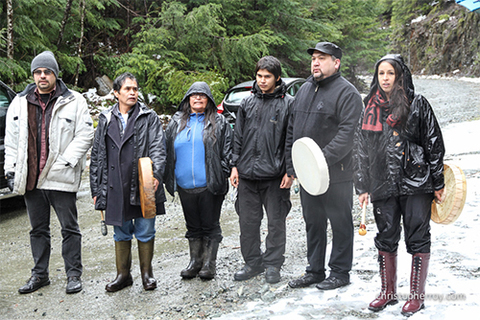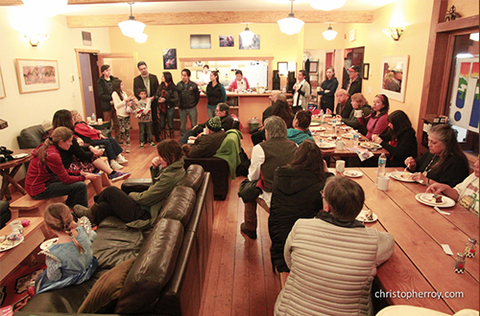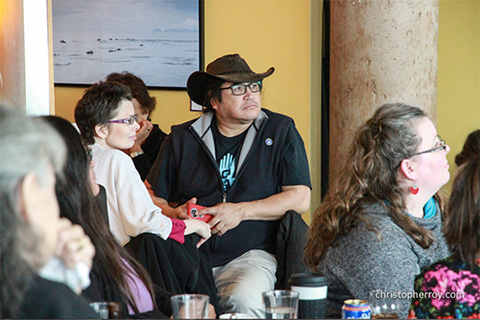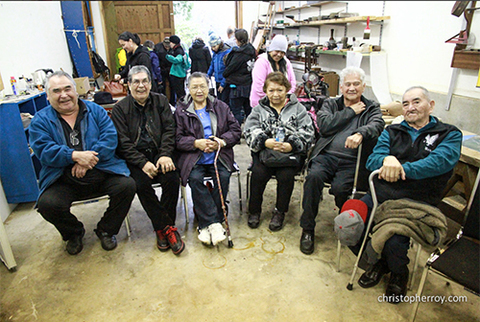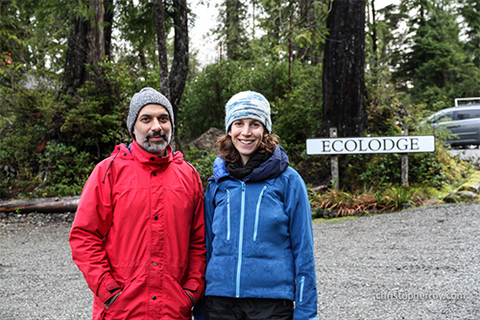David Suzuki's Blog, page 41
March 30, 2016
Will Toronto go wild about wild bees?
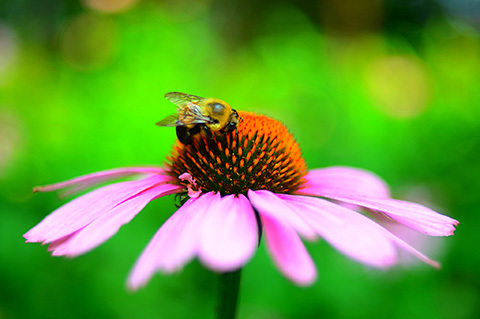
If you love bees, please read this.
While beekeepers, city councillors, American presidents and multinational breakfast cereal companies have become advocates for beloved honey bees, this is an important public service announcement on behalf of wild bees, the honey bees' lesser-known but vitally important bee cousins.
First, we don't want to seem ungrateful for the attention honey bees are receiving. It is wonderful that media outlets like the Toronto Star are really interested in bees (see here, here, here and here). And it is great that cities like Toronto aspire to be called a Bee City. Honey bees are now such a hot commodity that bee-loving campaigns are making headlines all the time.
That's why it's time for a quick lesson about the thousands of species of wild bees that have received less attention than the charismatic honey bee.
Honey bees are not native to North America. Before Europeans arrived, there were no honey bees on the continent. Zilch. Today, all of the honey produced in Canada is from a single species of European honey bee that is managed by beekeepers.
Bees aren't wasps, and are gentle. Bees are vegetarians and collect nectar and pollen from flowers. Wasps like yellow jackets are almost always the uninvited diners that you've swatted away and perhaps been stung by. This is because they have taken to human diets - enjoying fruit, sugary drinks and meat. These black-and-yellow aggressors often give bees a bad name.
Wild bee communities can be better pollinators than managed honey bees. While you may have heard that one-third of the food you eat was pollinated, honey bees are not the most effective pollinators. Studies have shown that wild bees can be two or three times better at pollination, and some, like mason bees, can be up to 80 times more effective. Cities are havens for wild bees and so their populations should be encouraged. It's surprisingly easy.
Wild bees don't live in hives. More than 90 per cent of wild bee species have a "solitary" lifestyle rather than living in large, social colonies like honey bees where there is one queen and many workers. In solitary bees, every female finds and builds a nest and lays eggs on her own. Two-thirds of these are ground-nesters, including mining, digger, and sweat bees that make nests in soil and under leaves and rocks. The rest are cavity-nesters like mason, leafcutter, and carpenter bees that burrow in hollow stems, twigs, holes in wood and even between bricks.
Toronto is a WILD bee city: Whether Toronto is formally designated a Bee City depends on a council vote this week. However, Toronto is home to several of the world's leading wild bee experts and has already established an impressive inventory of over 360 wild bee species that live in and around the city region.
You may be wondering why this all matters. It is important because wild bees and other pollinators are facing similar declines to honey bees. Threats range from pesticides and herbicides to loss of habitat to disease outbreaks and a dramatically changing climate.
To help bring back all bees, we need to continue creating vibrant gardens and naturalized green spaces with a variety of wildflowers that bloom from spring to fall. And because wild bees don't live in hives, we need to show them some love by making small changes to the way we manage our gardens and green spaces. For instance, you can create a wild bee sanctuary in your yard or garden by leaving a sunny patch of bare soil for ground-nesters. Add some pithy stems, sticks and decaying wood logs for cavity-nesters. And be sure not to disturb the nests over winter.
If your interest is piqued, you should check out the City of Toronto's forthcoming comprehensive guide to Toronto's bees, which is as beautifully presented as it is useful, and the David Suzuki Foundation's guide to pollinators.
Undoubtedly, the honey bee crisis has helped galvanize interest in bees and other pollinators. Now that the City of Toronto is considering becoming the country's first Bee City, let's get wild about the honey bees' hundreds of lesser-known wild bee cousins.
Sheila R. Colla is an Assistant Professor specializing in pollinator conservation at York University's Faculty of Environmental Studies. Scott MacIvor is a post-doctoral researcher in the Department of Biological Sciences at the University of Toronto Scarborough. Jode Roberts is an urban beekeeper and leads the David Suzuki Foundation's #gotmilkweed campaign and Homegrown National Park Project.
Hey! Want more DSF? Join David Suzuki on Facebook

March 28, 2016
Pacific Underwater Calendar: Spring is in the air - and the water
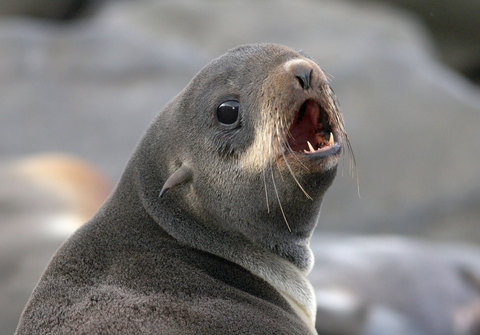
(Credit: Nate Swick via Flickr)
Spring is on the way, and with it, marine mammals such as grey whales, northern fur seals and sea otters travel thousands of kilometres to feed and give birth in more hospitable Pacific coastal waters.
After spending the winter in waters off the Baja peninsula, thousands of Pacific grey whales travel north in March. While most finish their migration in the Bering Sea, some choose B.C.'s coast as their final destination.
Although they're the only bottom-feeding whale, they display stereotypical whale characteristics: barnacle-covered, huge (at 15 metres long) and lacking dorsal fins. Every day, each whale swallows more than 1,000 kilograms of shrimp, worms and fish from the sea floor, filtering the food through baleen plates.
Northern fur seals can also be seen travelling along the North Pacific this time of year, with sightings common in the Hecate Strait near Haida Gwaii. Home turf ranges from Japan to southern California and up to the Bering Sea. B.C.'s coastal waters are important foraging areas, especially for pregnant females, which will then return to popular Alaskan rookeries.
They have characteristic external ears (pinnae), long muscular foreflippers and thick fur coats. Males are up to 40 per cent longer and more than four times heavier than females. They have a varied and broad taste palette, feeding on fish (pollock, herring, salmon, mackerel and anchovies), squid and occasionally birds. They are preyed on by sharks and orcas.
Fur seals spend more than half the year in the open ocean and sleep on their backs, their fins sticking out of the water like jug handles. Pups can remain at sea for up to 22 months.
Sea otters off the North Pacific coast give birth in spring. They mate, sleep, hunt and give birth off the west coast of Vancouver Island and in central coastal waters. Newborn pups float like corks, aided by lanugo coats that take at least two months to shed before the pups can start diving. Mothers float on their backs and care for their babies on their stomachs.
These charismatic creatures can be found swimming and resting in kelp forests, bays, reefs and fjords, floating on their backs and feasting on local delicacies such as clams, mussels, chitons, prawns, abalone and sea urchins. Because sea otters' feeding habits can affect the entire ecosystems in which they live, they have an important influence on habitat and marine life in kelp forests. They rely on touch, using their agile front paws and whiskers to find food. These voracious eaters swallow up to 30 per cent of their body weight each day and are one of the few mammals that use tools, such as rocks, to pry and split shellfish. They store food in loose skin pockets under their forearms. Orcas, sharks and bald eagles often eat sea otters.
Dwindling numbers
Grey whales
Although hunting bans have helped grey whale populations rebound to about 18,000 in B.C. they remain a "species of concern" under federal law.
They face threats from orcas, industrial pollution, fishing gear, noise and propeller cuts from marine vessels and warming and acidifying oceans related to climate change. With the possibility of increased tanker shipping, these whales still aren't in safe waters.
Northern fur seals
While there are up to 500,000 of these seals, that's likely less than half their 1950s numbers. Over the past 30 years their population has dropped by 36 per cent. The Committee on the Status of Endangered Wildlife in Canada lists them as "threatened."
Threats include availability of prey, changes in ocean conditions, marine debris, environmental pollutants and interactions with vessels and humans.
Sea otters
By the 1800s, sea otters had been hunted to extinction along B.C.'s coast. The good news is they've now recovered to 5,000 and have been down-listed from "threatened" to "special concern". B.C.'s otters are the descendants of 89 relocated Alaskan sea otters.
Threats include availability of prey, oil spills and environmental contamination and conflicts with commercial fisheries.
What you can do
Join the B.C. Cetacean Sightings Network and collect data on cetaceans and sea turtles http://scistarter.com/project/1004-BC%20Cetacean%20Sightings%20Network
Monitor marine mammal populations with a digital app, such as Whale mAPP: http://scistarter.com/project/1303-Whale%20mAPP
Explore the underwater oceans around the world with Google Street View Oceans: http://www.google.com/maps/streetview/#oceans
« Explore more of the Pacific Underwater Calendar
Hey! Want more DSF? Join David Suzuki on Facebook

March 25, 2016
Federal budget is a good step in addressing water crisis in Indigenous communities
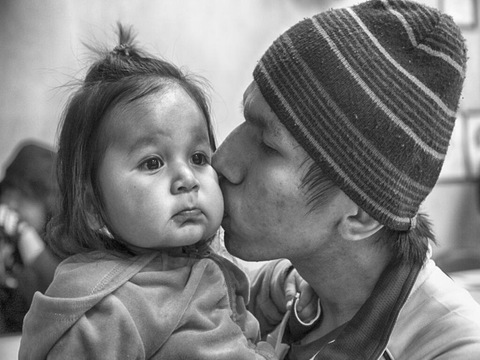
Children in Indigenous communities are often at risk from bad water. Photo by Sherry Prenevost.
Few of us can imagine not being able to turn on the tap to get clean water for drinking, cooking and bathing. But this is the reality in hundreds of Indigenous communities across Canada, where watersheds are degraded or tainted by pollution, including from oil and gas development such as the Alberta oilsands. Many communities lack critical infrastructure to keep tap water safe. A recent CBC investigation revealed that 400 of 618 First Nations in the country experienced problems with water between 2004 and 2014.
In our work with First Nations in the far north of Ontario, British Columbia and Manitoba, the David Suzuki Foundation has visited communities that have been on boil-water advisories for decades, such as the Neskantaga First Nation and Shoal Lake 40 First Nation.
In these communities, young people have never been able to drink from the tap. Instead, they've had to rely on bottled water trucked or flown in at an enormous cost to the community. Drinking or bathing in unsafe water has caused outbreaks of skin rashes, intestinal ailments and other problems, often among children.
Yesterday, with its first budget, the federal government followed up on an election promise to make clean water in Indigenous communities a priority and to end the need for boil-water advisories in Indigenous communities within five years.
The federal budget allocates $141.7 million over five years for monitoring and testing drinking water in Indigenous communities across Canada and $1.8 billion over the same time period for clean water infrastructure, such as water-filtration plants. Most importantly, money is being allocated to ensure that community members are trained to monitor water quality and to operate and maintain critical water infrastructure.
The David Suzuki Foundation is pleased to see that the prime minster is following up on his promise and that the government will invest hundreds of millions of dollars in Indigenous communities to ensure they receive the same level of service as all Canadians when it comes to clean drinking water. The Foundation asked for these investments through our participation in the Green Budget Coalition and through our ongoing Right to a Healthy Environment campaign to enshrine environmental rights, like access to clean water, in the Canadian Constitution.
Although the allocation for clean water infrastructure falls short of recommendations made in a recent report commissioned by the government, the Assembly of First Nations hailed the budget as "a significant step in closing the gap in the quality of life between First Nations peoples and Canadians and beginning the process of reconciliation."
AFN National Chief Perry Bellegarde said, "The budget begins to address decades of underfunding and neglect, which have perpetuated a growing gap in the quality of life between First Nations and other Canadians."
Investments in clean water in Indigenous communities are important in ensuring equity and reconciliation between Aboriginal and non-Aboriginal people in Canada. We must not forget that Canada has obligations to its First Peoples, enshrined in treaties and international agreements.
The federal budget offers a good first step to ensuring that these agreements are honoured and upheld, and that the health and well-being of Indigenous peoples are better supported.
Hey! Want more DSF? Join David Suzuki on Facebook

March 24, 2016
Environmental deficit tarnishes Canada's rights record
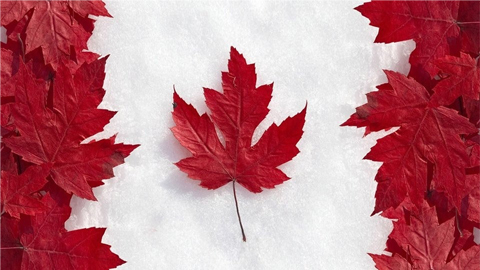
(Credit: Kyle Pearce via Flickr)
Many Canadians see our country as a human rights leader, but a United Nations committee says we should do better. In early March, the Committee on Economic, Social and Cultural Rights concluded that Canada’s lack of environmental protection and climate action mars our rights record.
The committee’s periodic review of Canada put our country’s commitment to providing basic necessities under the spotlight. Although the review’s authors commended Canada for several progressive steps, including the recently announced national inquiry into missing and murdered Indigenous women and girls, they expressed concern about the systematic lack of action on homelessness, poverty, access to food and other important obligations under the International Covenant on Economic, Social and Cultural Rights.
Their recommendations on environmental protection and climate change policy were especially noteworthy. Although it’s evident that a healthy environment is the foundation of human rights to food, water, health and livelihood, the committee’s decision to push Canada to pursue renewable energy, reduce greenhouse gas emissions and establish stronger environmental regulations illustrates the growing global recognition of the link between environmental and human rights.
This recognition may be just emerging in international human rights law, but it’s nothing new to Indigenous people and many others who directly depend on nature for food and livelihood.
I heard this over and over again this past summer as I travelled with a team along Canada’s vast Pacific coast, visiting a dozen communities in the traditional territories of 12 First Nations. These people reside along 26,000 kilometres of British Columbia’s winding shoreline — home to trillions of plankton, billions of fish, millions of seabirds and thousands of whales, which live among forests of kelp and eelgrass, along underwater canyons and glass sponge reefs.
During the tour, we were welcomed with feasts that embodied the intersection of nature, food and culture, and we conducted more than 1,500 profoundly moving interviews with coastal residents. They expressed fears about threats to their way of life, including industrial projects that will catastrophically affect the environment and their livelihoods being approved with little or no consultation. They spoke passionately about the connection between a healthy environment and economic, cultural and social rights — because they live it every day.
One Pacific coast resident said, “When the fish come home or pass by Campbell River this whole community comes alive. Without the fish, a large piece of our island culture goes with them.” Another observed, “When we think of human rights, we think of equality, freedom, democracy. But what good are any of those if we don’t have clean air, soil and water? It has to start with nature.”
These and many other statements from Pacific coastal residents, which formed the basis of a David Suzuki Foundation submission to the UN committee, resonated at the international level. Observations of the effects of climate change on their communities — including unpredictable and extreme weather, decreasing snow and ice, water shortages, wildfires and salmon spawning failures — mirror the findings of the Intergovernmental Panel on Climate Change.
This is a critical moment for Canadians as we face mounting pressure from climate change, ocean acidification and industrial development. With the longest coastline of any nation, our country holds a globally significant responsibility to protect its oceans, which are under threat from failures to address carbon emissions and ensure marine protection and management. Canada can start by acting on its commitment to protect 10 per cent of its marine environment by 2020, and by putting strict targets on greenhouse gas emissions.
We could also go a long way toward meeting our international human rights obligations by joining more than 110 nations in constitutionally recognizing the right to a healthy environment. Taking immediate steps to restore and enhance robust environmental protection, fully respect Indigenous rights to title and consultation, and protect ocean ecosystems from degradation and climate change is essential.
The growing international recognition of the disproportionate impacts on Indigenous and vulnerable people enhances the understanding that protecting the environment is as much about social justice as keeping ecosystems healthy.
This year marks the 50th anniversary of the International Covenant on Economic, Social and Cultural Rights. Canada has the opportunity to mark the milestone by legally protecting all Canadians’ environmental rights and by recognizing that healthy oceans are a necessary condition for human health and dignity.
Hey! Want more DSF? Join David Suzuki on Facebook

March 22, 2016
Budget 2016 contains many small steps, no large leap, on environment
The David Suzuki Foundation welcomed today's federal budget as the first in almost a decade that seriously commits funding to climate change and clean energy, habitat conservation and a healthy environment.
"After nearly a decade of federal budgets that pitted the environment against the economy, it is refreshing to see a budget that acknowledges a prosperous Canada depends on healthy ecosystems and a transition to a clean economy," said David Suzuki Foundation CEO Peter Robinson. "At the same time, we're concerned that the level of investment doesn't match the urgency of the environmental challenges Canada faces."
Leadership on clean energy and climate change:
Although total investment in public transit infrastructure is not what we hoped it would be, the commitment to fund up to 50 per cent of project costs shows federal leadership. The David Suzuki Foundation believes the best way to build healthy and sustainable communities is through more robust investment in public transit infrastructure.
Highlights include:
$3.4 billion for public transit over three years, starting in 2016-17.
$62.5 million over two years to support the deployment of infrastructure for alternative transportation fuels.
Conserving and protecting critical habitat
Though this budget moves us in the right direction in ocean science and conservation, it fails to provide adequate funding to meet targets based on Green Budget Coalition recommendations.
Highlights include:
$81.3 million over five years to support marine conservation activities
$197.1 million over five years to increase ocean and freshwater science, monitoring and research activities.
While this budget delivered on a number of key promises and helps move Canada toward a sustainable path, the lack of an announcement on carbon pricing, no meaningful investments in renewable energy development and the missed opportunity to phase out fossil fuel subsidies leave a lot of questions unanswered.
"If the government is serious about moving toward a clean energy future, a price on carbon and an end to fossil fuel subsidies must be part of the equation, and soon," Robinson said.
Media contacts:
Alvin Singh
Communications Manager
604-250-2651
asingh@davidsuzuki.org
Hey! Want more DSF? Join David Suzuki on Facebook

Budget 2016 contains many small steps but no large leap for the environment
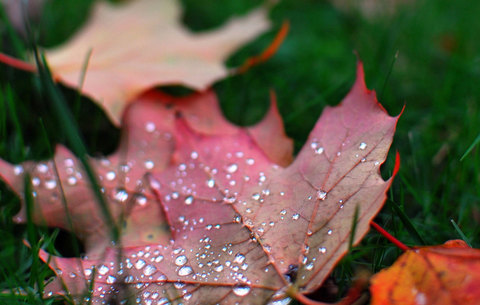
(Credit: Morgan via Flickr)
The David Suzuki Foundation welcomed today's federal budget as the first in almost a decade that seriously commits funding to climate change and clean energy, habitat conservation and a healthy environment.
After nearly a decade of federal budgets that pitted the environment against the economy, it is refreshing to see a budget that acknowledges a prosperous Canada depends on healthy ecosystems and a transition to a clean economy. At the same time, we're concerned that the level of investment doesn't match the urgency of the environmental challenges Canada faces.
Leadership on clean energy and climate change
Although total investment in public transit infrastructure is not what we hoped it would be, the commitment to fund up to 50 per cent of project costs shows federal leadership. The David Suzuki Foundation believes the best way to build healthy and sustainable communities is through more robust investment in public transit infrastructure.
Highlights include:
$3.4 billion for public transit over three years, starting in 2016-17.
$62.5 million over two years to support the deployment of infrastructure for alternative transportation fuels
Conserving and protecting critical habitat
Though this budget moves us in the right direction in ocean science and conservation, it fails to provide adequate funding to meet targets based on Green Budget Coalition recommendations.
Highlights include:
$81.3 million over five years to support marine conservation activities and $197.1 million over five years to increase ocean and freshwater science, monitoring and research activities.
While this budget delivered on a number of key promises and helps move Canada toward a sustainable path, the lack of an announcement on carbon pricing, no meaningful investments in renewable energy development and the missed opportunity to phase out fossil fuel subsidies leave a lot of questions unanswered.
If the government is serious about moving toward a clean energy future, a price on carbon and an end to fossil fuel subsidies must be part of the equation, and soon.
Hey! Want more DSF? Join David Suzuki on Facebook

How to lure pollinators with sunflowers
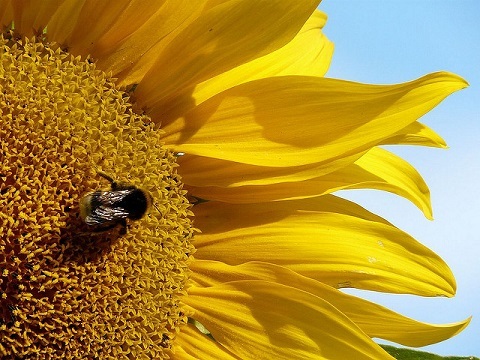
Sunflowers are rich sources of nectar and pollen for honeybees, bumblebees and other wild bee species, butterflies and other beneficial insects. (Credit: Nick Grapsy via Flickr)
Your garden is bee and butterfly-friendly. You've made a bee bath, a bumblebee house and count birds in your backyard. What's left?
I quizzed Mark from West Coast Seeds about the benefits of growing sunflowers!
All garden sunflowers are descended from the Central American Helianthus annuus.
Conventional plant breeding allows for selection of height, flower size and colour, and size or oil content of seeds. Russian mammoth and giganteus grow ten feet tall or more in a single season, with a stem more like a tree trunk. Each flower head "face" is actually individual florets tightly packed into a spiral pattern. Each pollinated floret produces a single sunflower seed. Really big sunflowers produce hundreds of seeds!
Which pollinators like sunflowers?
Sunflowers' height makes them beacons for pollinators, rich sources of nectar and pollen for honeybees, bumblebees and other wild bee species, butterflies and other beneficial insects.
Planting sunflowers in your food garden lures the most important insects and will improve pollination for a host of fruits and vegetables.
When should I plant sunflowers?
Wait until the ground warms up in the spring before sowing the seeds (West Coasters start planting in April and May). This will allow each plant to anchor roots in the soil.
Get kids involved! The seeds are big -- easy for tiny hands. Push each seed two centimetres (one inch) into the soil. Big varieties need to be spaced three to five feet apart, but tiny ones will grow one foot apart (or one plant per three-gallon container).
Note: Sunflowers started in containers sometimes have root growth interrupted and may not develop a sturdy anchor for staying upright in stormy weather.
How much space do I need?
Not all sunflowers are tall. Choose dwarf varieties, like music box (grows a few feet) for raised beds or in large containers, like half-barrels. For small spaces, choose tiny suntastic, which reaches about 30 centimetres (12 inches) tall, doesn't produce edible sunflower seeds, but adds colour to patio containers.
How will I know when to harvest sunflower seeds?
Seeds are ready to harvest when birds make frequent visits. Seeds from large sunflower species contain a substantial amount of oil -- much loved by chickadees!
Love birds? Leave the flower in the garden as a natural fall and winter bird feeder.
Where will you plant sunflowers?
Comment on this blog to win a package of sunflower seeds donated by West Coast Seeds. (Draw date: April 12, 2016)
Sincerely,
Lindsay Coulter, a fellow Queen of Green
Hey! Want more DSF? Join David Suzuki on Facebook

Tribal parks offer hope and empowerment
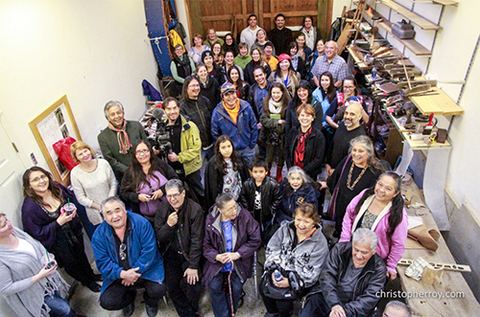
(Credit: Christopher Roy)
From March 10 to 14, Faisal Moola and I, Rachel Plotkin, of the David Suzuki Foundation's Ontario and Northern Canada office, had the privilege of attending a gathering in spectacular (and wet!) Tla-o-qui-aht traditional territory, B.C., to discuss tribal parks. The gathering was hosted by Tla-o-qui-aht Tribal Parks.
Tribal parks are conservation areas envisioned, declared and managed by Indigenous communities. They are also a means for Indigenous communities to assert their responsibilities and rights to steward and manage their lands and resources. DSF supports tribal parks and is working with some communities, including the Doig River First Nation, to advance their establishment.
We felt so lucky to be at the tribal parks gathering, surrounded by elders and community members from Tla-o-qui-aht, Halalt, Doig River, Heiltsuk, Sliamon, Chumash, Amah Mutsun, Haida, Algonquin, Garden River, Cape Mudge, Kwakwaka'wakw, Xeni, Yunesit'in and Xeni Gwet'in First Nations (including 2015 North American Goldman Prize recipient Marilyn Baptiste), as well as the Sinkyone Tribal Council and local supporters and activists.
Over the course of five days we heard from many elders and community members. They spoke about industrial development and the importance of maintaining remnant forest stands in highly developed territories, and about the decline of caribou and moose, which they rely on for subsistence. We learned from the California contingent the heartbreaking story of their past, as they suffered at the hands of both the state (which offered bounties for killing Indigenous people) and the missions (which forcibly took them in and away from their cultures and ways of life much like residential schools in Canada).
We also talked about the empowerment that the assertion of responsibility can bring, such as the Heiltsuk's assertion of sovereignty, which led the community to a place of strength; the slow steady climb of the Amah Mutsun to regain the role of land stewards through land trusts in California; and the potential of Indigenous watershed governance areas to sustain watersheds and provide services and sustainable livelihoods to local communities. We discussed framing tribal parks as "Reconciliation Gardens" and the need for non-Indigenous people to learn from Indigenous people the concept of managing lands and waters for "abundability" instead of "sustainability."
Faisal and I left the gathering much fuller than when we arrived, our heads filled with ideas for moving forward and our hearts filled with the honour of having shared such powerful and moving stories of pain, reconciliation and hope.
Additional pictures can be viewed here.
Hey! Want more DSF? Join David Suzuki on Facebook

How you can help water
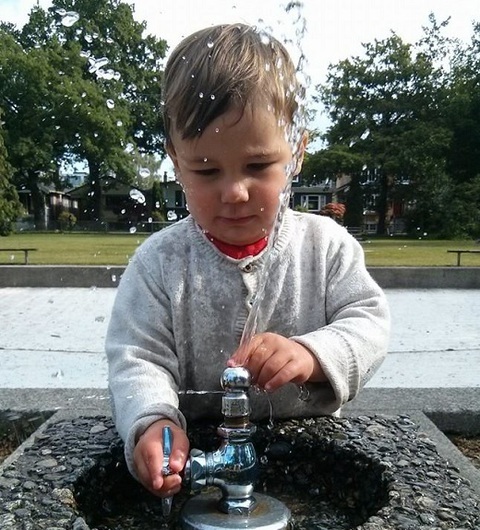
Find creative ways to play with water that are less wasteful. (Credit: Lindsay Coulter)
March 22 is World Water Day!
But what can you really do for water?
During the 2015 summer drought, I created a list of five home watering-saving tips and wrote about how to get your yard off grass. And that summer of water restrictions inspired six more tips:
Save water from going down the drain. For example, after boiling a pot of corn on the cob or steaming veggies, let the water cool and then use it on indoor and outdoor plants.
Save bath or shower water. Use it to rinse toothpaste down the sink (unless it's my coconut oil toothpaste recipe which you should spit into the compost), wash floors, for water play (see below), etc.
Put a rinse basin in the sink. Collect water from rinsed dishes or running the tap to nourish plants. (And a few coffee grinds won't hurt!)
Wash other people's dishes. Hate to see water wasted? Don't preach. Offer to be the dishwasher at the next house party or BBQ.
Find other toys for toddlers. Water is the best toy -- pour it, splash in it, etc. -- but it's wasteful. My son lost his garden hose privileges. Find other ways to encourage water play, like using bath water outside for mud kitchen.
Encourage bumblebees. Bumblebees nesting in your yard increase water movement around plant roots, so on watering days it can get to plants easier and where it's needed most!
Thirsty to take a bigger step this World Water Day?
The David Suzuki Foundation's Blue Dot movement is helping communities across Canada to call on the federal government to make good on our human right to clean water by enacting a federal environmental bill of rights.
Did you know that Canada is the only G8 country and one of just two OECD countries without legally enforceable national drinking-water-quality standards?
Write a letter to the editor calling for water rights. We created a simple tool, so beginners are welcome.
Join our THUNDERCLAP for water rights! Thousands of Canadians are sending one unified message to the federal government on World Water Day.
Comment on this blog with one NEW action you'll adopt this World Water Day and be entered to win a reusable, glass straw donated by Aimee of the Glass Sipper (draw date: April 11, 2016).
Sincerely,
Lindsay Coulter, a fellow Queen of Green
Hey! Want more DSF? Join David Suzuki on Facebook

March 17, 2016
World Water Day reminds us not to take clean water for granted
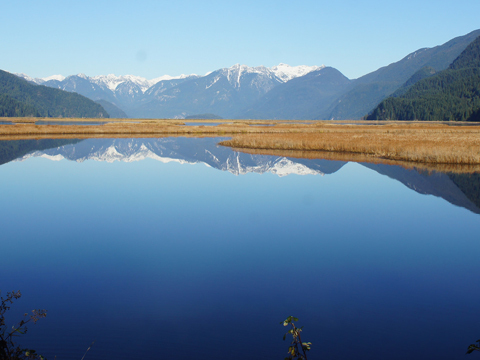
(Credit: Tjflex2 via Flickr).
Earth's oceans, lakes, rivers and streams are its circulatory system, providing life's essentials for people, animals and ecosystems. Canada has one-fifth of the world's freshwater, a quarter of its remaining wetlands and its longest coastline. With this abundance, it's easy to take water for granted. Many of our daily rituals require its life-giving force. Yet do we recognize our good fortune in having clean, safe water at the turn of a tap?
Not everyone in Canada is so lucky. On any given day, more than 1,000 boil-water advisories are in place across the country. Imagine having to walk to your local church every morning to fill plastic jugs with clean drinking water for your family. Or having to drive to your town's fire station or community centre to collect bottled water. Imagine having to boil water for everything you do at home -- cooking, cleaning, washing. This is the sad reality for people who live in communities with boil-water advisories, some for decades at a time.
Water problems are dangerous. In May 2000, bacteria in Walkerton, Ontario's water supply caused seven deaths and more than 2,300 illnesses. A public inquiry blamed the crisis on flaws in the province's approval and inspection programs, a "lack of training and expertise" among water-supply operators and government budget cuts.
In 2001, nearly half of North Battleford, Saskatchewan's 14,000 residents became ill from contaminated water. An inquiry concluded provincial oversight was inadequate and ineffective.
Indigenous communities continue to face a widespread drinking water crisis, with people on First Nations reserves 90 times more likely than other Canadians to lack access to clean water.
Health Canada reports that 131 drinking-water advisories were in effect in 87 Indigenous communities at the end of 2015, not including British Columbia. Places like Shoal Lake 40, Grassy Narrows and Neskantaga have been under boil-water advisories for decades. In B.C., the First Nations Health Authority reports that 28 drinking-water advisories were in effect in 25 Indigenous communities as of January 31, 2016.
How can this continue in a water-rich country like Canada?
Canada recognized the right to water at the United Nations Conference on Sustainable Development in 2012. Yet our government has failed to live up to its commitment. As a 2015 UN report points out, "The global water crisis is one of governance, much more than of resource availability, and this is where the bulk of the action is required in order to achieve a water secure world."
We are the only G8 country, and one of just two OECD countries, without legally enforceable national drinking-water-quality standards. Federal water policy is more than 25 years old and in dire need of revision. We have no national strategy to address urgent water issues and no federal leadership to conserve and protect water. Instead, we rely on a patchwork of provincial water policies, some enshrined in law and some not. Meanwhile, highly intensive industrial activities, agribusiness and pollution are putting water supplies at risk.
The federal government will deliver its first budget on March 22 -- World Water Day. The David Suzuki Foundation's Blue Dot movement is also taking a stand on World Water Day, helping communities across Canada call on the federal government to make good on our human right to clean water by enacting a federal environmental bill of rights.
Canada's environment and climate change minister has a mandate to "treat our freshwater as a precious resource that deserves protection and careful stewardship." The government could take a big step toward accomplishing this by recognizing our right to a healthy environment, including our right to clean water.
The government should also implement legally binding national standards for drinking water quality equal to or better than the highest standards in other industrialized nations, and set long-term targets and timelines to reduce water pollution. And it should fulfil our right to water by addressing the drinking water crisis in Indigenous communities and establishing a Canada Water Fund to foster the clean-water tech industry and create a robust national water quality and quantity monitoring system.
Committing to these actions would help ensure all Canadians have access to clean, safe water for generations to come. On World Water Day, help protect the people and places you love by joining the Blue Dot movement.
Take action -- speak up about water rights!
Hey! Want more DSF? Join David Suzuki on Facebook

David Suzuki's Blog
- David Suzuki's profile
- 247 followers


